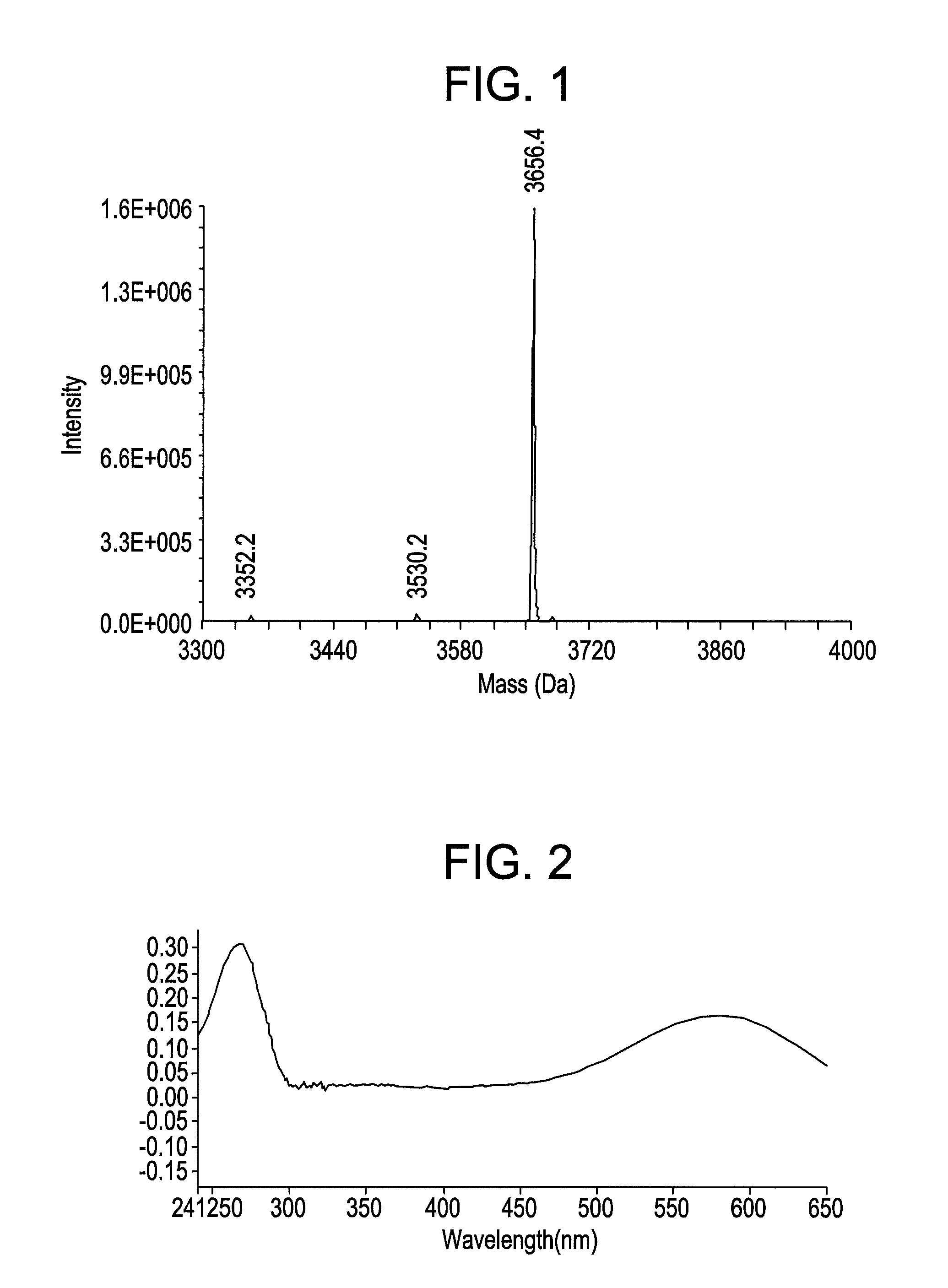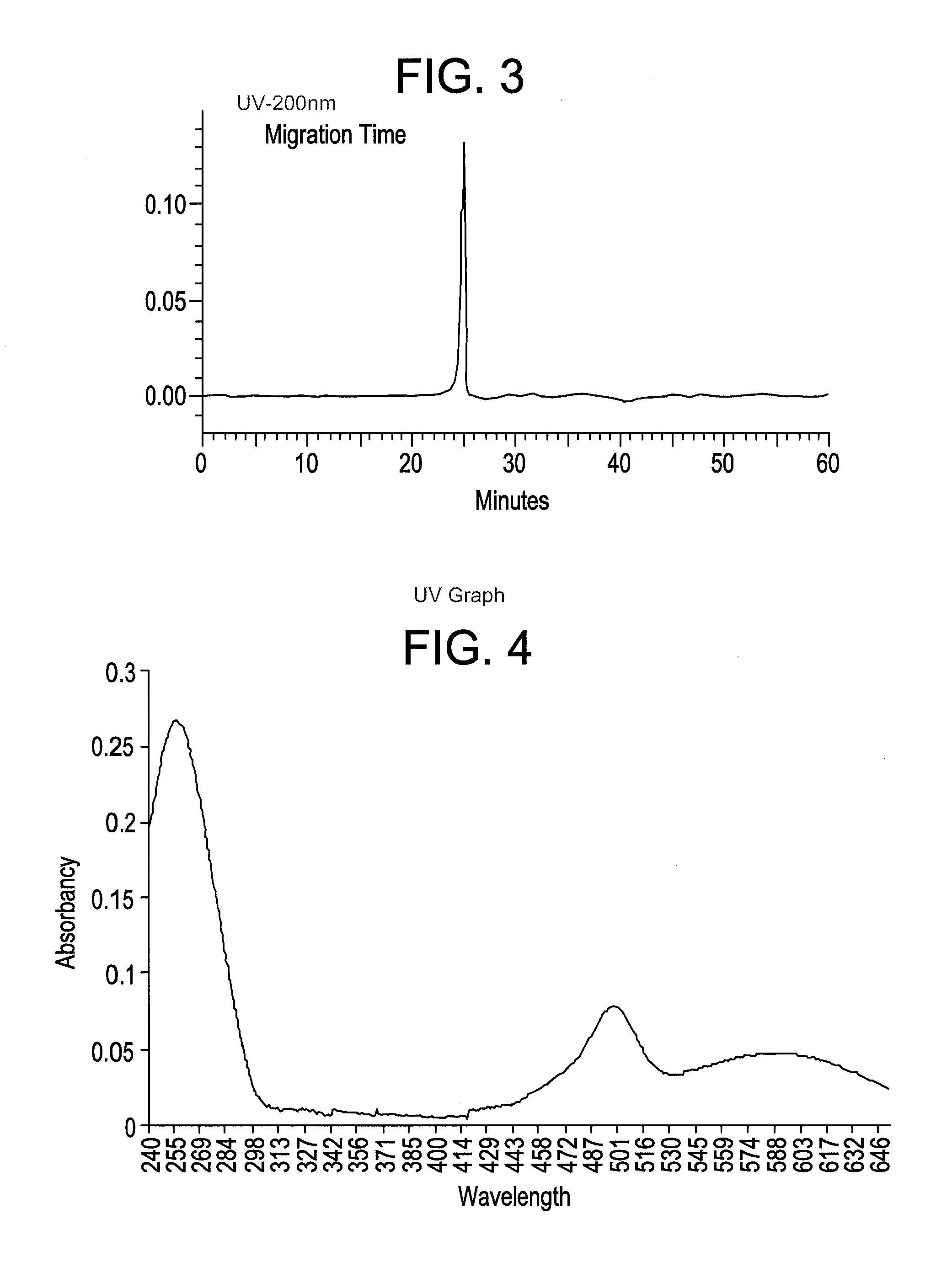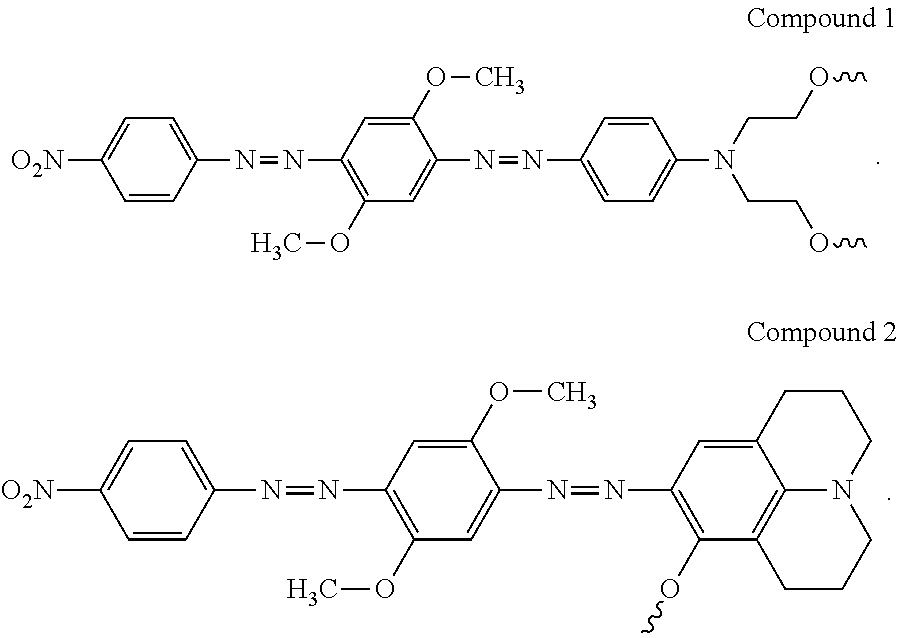Synthesis of novel azo-dyes and their use in oligonucleotide synthesis
a technology of azodyes and oligonucleotides, which is applied in the field of synthesis of novel azodyes and their use in oligonucleotide synthesis, can solve the problems of increasing the distance between the donor and the quencher, complicating the design of the probe that utilizes frets, and increasing the fluorescent signal of the donor, so as to achieve strong fluorescence quenching properties and easy manufacturing and purification
- Summary
- Abstract
- Description
- Claims
- Application Information
AI Technical Summary
Benefits of technology
Problems solved by technology
Method used
Image
Examples
example 1
[0081]Synthesis of 5-(2-nitro-4-carboxyphenylazo)-1,3,3-trimethyl-2-methyleneindoline (6). To a cold solution of 10 g (54.9 mmol) of 2-nitro-4-aminobezoic acid (5) and 2.4 g (22.6 mmol) of sodium carbonate in 100 mL of DI water was added a solution of 3.5 g (50.7 mmol) of NaNO2 in 10 mL of DI water at 15° C. with stirring. The above mixture was poured into a mixture of 10 mL of concentrated HCl and 60 gm of crashed ice with stirring. Then of 9.5 g (54.9 mmol) of 1,3,3-trimethyl-2-methyleneindoline and 6 ml of acetic acid were added to the reaction mixture. After 10 min the reaction mixture was neutralized with 8 mL of 20% NaOH solution in water. The precipitant was filtered. Flash chromatography with chloroform / hexanes / acetone 5:3:2 mobile system provided 7 g (34.7%) of azo bezoate (6) as orange solid. TLC Rf 0.23 (chloroform / hexanes / acetone 5:3:2). UV / Vis (buffer pH=11) λmax (nm) 490 (ε=38,200 M−1cm−1). ESIMS 367.6 [C19H18N4O4 (M+H)+ requires 367.4].
[0082]
[0083]Synthesis of 2-(5-(5...
example 3
[0086]Synthesis of 5-(4-(4-carboxamidophenylazo)-2,5-dimethoxyphenylazo)-1,3,3-trimethyl-2-methyleneindoline phosphoramidite (11). The synthesis was as shown in Scheme 3 below.
[0087]4-(4-carboxyphenylazo)-2,5-dimethoxyaniline (8). To a cold solution of 10 g (72.9 mmol) of p-aminobezoic acid (3) and 2.4 g (22.6 mmol) of sodium carbonate in 100 mL of DI water was added a solution of 3.5 g (50.7 mmol) of NaNO2 in 10 mL of DI water at 15° C. with stirring. The above mixture was poured into a mixture of 10 mL of concentrated HCl and 60 gm of crashed ice with stirring. Then of 11.2 g (73.2 mmol) of dimethoxyaniline (7) and 6 ml of acetic acid were added to the reaction mixture. After 10 min the reaction mixture was neutralized with 8 mL of 20% NaOH solution in water. The precipitant was filtered. Flash chromatography with chloroform / hexanes / acetone 5:3:2 mobile system provided 16 g (72.7%) of azo bezoate (8) as orange solid. TLC Rf 0.33 (1:9 MeOH-DCM). UV / Vis (methanol) λmax (nm) 450 (ε=3...
example 4
[0092]Synthesis of 5-(4-(4-carboxamidophenylazo)-2,5-dimethoxyphenylazo)-1,3,3-trimethyl-2-methyleneindoline derivatized CPG (14). The synthesis was as shown in Scheme 4 below.
[0093]DMT Protected azo alcohol 13. To the solution of 500 mg (1.03 mmol) of 5-(4-(4-carboxyphenylazo)-2,5-dimethoxyphenylazo)-1,3,3-trimethyl-2-methyleneindoline (9) and 177 mg (1.55 mmol) of N-hydroxy succinimide in 5 mL of DMF were added 233 mg (1.13 mmol) of DCC at room temperature under nitrogen with stirring. After 12 hrs the reaction mixture was filtered and 599 mg (1.33 mmol) of alcohol 12 were added to the reaction mixture at room temperature with stirring. After 12 hrs the reaction mixture was diluted with 50 mL of chloroform and washed with 30 mL of brine. The organic layer was separated and dried over anhydrous Na2SO4. Flash chromatography with Flash chromatography with 5:4:1 ethylacetate / hexanes / triethylamine mobile system provided 750 mg (79.3%) of the compound 13. TLC Rf 0.48 (8:92 MeOH-DCM). UV...
PUM
| Property | Measurement | Unit |
|---|---|---|
| wavelength range | aaaaa | aaaaa |
| wavelength range | aaaaa | aaaaa |
| wavelength range | aaaaa | aaaaa |
Abstract
Description
Claims
Application Information
 Login to View More
Login to View More - R&D
- Intellectual Property
- Life Sciences
- Materials
- Tech Scout
- Unparalleled Data Quality
- Higher Quality Content
- 60% Fewer Hallucinations
Browse by: Latest US Patents, China's latest patents, Technical Efficacy Thesaurus, Application Domain, Technology Topic, Popular Technical Reports.
© 2025 PatSnap. All rights reserved.Legal|Privacy policy|Modern Slavery Act Transparency Statement|Sitemap|About US| Contact US: help@patsnap.com



